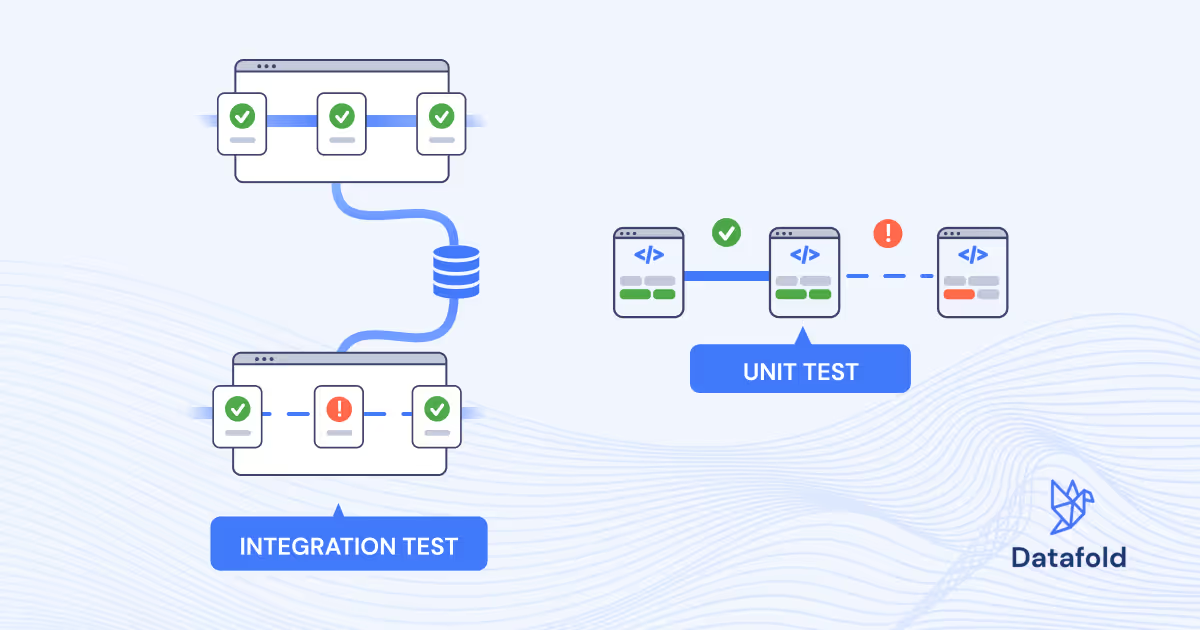BladeBridge alternatives: Why Datafold is the best choice
BladeBridge, now part of Databricks, automates legacy data platform migrations but is limited to Databricks SQL as the target. Datafold’s Migration Agent offers a more flexible, AI-powered solution that supports multiple target platforms and provides advanced value-level data validation. In this article, we’ll provide a detailed technical comparison between the two tools.

BladeBridge helps businesses migrate legacy data platforms. But the BladeBridge you previously knew is not the same today, post-Databricks acquisition. Today, Databricks SQL is the only applicable target for BladeBridge-supported migrations.
If you’re stuck maintaining ancient data systems, you know the pain: migrations are slow, manual, and expensive. BladeBridge promises to ease that pain by automating some of the process, making data modernization somewhat faster and more efficient.
But here’s the catch: BladeBridge is now locked into Databricks SQL. If you’re already committed to the Databricks ecosystem, this integration can be helpful. But this also makes BladeBridge highly restrictive and leaves teams with no flexibility to choose a different platform or adapt to multi-cloud strategies.
BladeBridge’s limitations include:
- No value-level data validation: It stops at schema-level checks and doesn’t verify if actual data values match between source and target.
- Rule-based automation only: BladeBridge follows predefined rules, so complex code may break and require manual fixes.
- No iterative learning: There is no “translate, diff, repeat” feedback loop powered by advanced AI or large language models to fine-tune conversions until complete parity is achieved.
- Limited workflow transformation: It translates SQL and ETL scripts but doesn’t support modern workflow tools like dbt or Coalesce.io.
In contrast, Datafold’s Migration Agent (DMA) is data warehouse agnostic and stands out for its true automation with both code conversion and validation. It leverages an LLM-powered feedback loop that fine-tunes translations until perfect parity is achieved.
DMA goes further by performing automated value-level data validation, comparing every data point across legacy and new systems. This isn’t just schema-level validation—it’s value-level comparison to ensure that every record is migrated perfectly.
It’s this level of automation and precision that makes Datafold the superior choice for complex migrations or high-stakes data integrity requirements.
In this article, we’ll compare BladeBridge’s features to DMA’s to see what each does well and where they fall short. By the end, you’ll have a clearer sense of which tool is right for your migration project and why the choice matters more than you might think.
What is BladeBridge and how does it work?
BladeBridge uses a multi-tool approach to handle data migrations. As technical documentation on how it works isn’t widely available, we pieced together its capabilities from product descriptions to understand what it does well, where it has limitations, and how it stacks up against Datafold’s Migration Agent. (If you’re ready to get into the technical weeds, check out DMA’s docs or this blog that looks into how DMA works).

Here’s a breakdown of its key components to understand exactly what it does—and what it doesn’t do.
BladeBridge features and benefits
BladeBridge comes with a four-part suite of offerings designed to address the complexities of data migrations:
- Analyzer: It profiles databases, stored procedures, and ETL workflows, giving you a clear map of what you’re working with. This helps you understand the scope and complexity of your migration, making it easier to plan timelines and resources. However, it focuses on inventory and complexity analysis; it doesn’t provide deep lineage tracking or impact analysis at the column or value level.
- Converter: This is the workhorse of BladeBridge. It translates legacy code—including SQL, stored procedures, and ETL scripts—into Databricks-compatible code. While this saves time on manual rewriting, the translations are rule-based which means that complex or unconventional code patterns can easily break and require tedious manual fixes.
- Data Recon: Like a proofreader but for data, it compares source and target schemas to validate dependencies and highlight discrepancies. But BladeBridge stops at schema-level checks. It doesn’t perform value-level data validation, leaving gaps in accuracy. If you need to verify that every single data point matches exactly, you’ll need another tool for that.
- Studio: Studio generates clean, maintainable code that follows best practices. But it’s designed purely for consistency and standardization, not transformation. If you’re looking to modernize data workflows—like moving from stored procedures to dbt models or Coalesce.io—BladeBridge simply isn’t built for that.
BladeBridge migration solution pros and cons
BladeBridge’s strength lies in its broad platform support and configurable framework. It translates code from both traditional SQL environments and GUI-based ETL systems.
However, while BladeBridge performs well in automating schema and metadata validations, it lacks the level of granular, value-level data diffing and iterative, LLM-powered feedback loops found in more advanced AI-powered solutions like Datafold. This limits its ability to automatically fine-tune translations until perfect parity is achieved.
Comparing Datafold and BladeBridge
When comparing BladeBridge with Datafold’s Migration Agent (DMA), several key differences emerge. While both tools aim to simplify data migrations, Datafold leverages advanced AI to deliver superior accuracy, flexibility, and speed. This AI-driven approach gives DMA a distinct edge, especially for complex migrations or high-stakes data integrity requirements.
BladeBridge uses rule-based automation that follows predefined patterns. This makes its translations consistent but rigid, often requiring manual intervention for unconventional code patterns. Datafold, on the other hand, uses a sophisticated, LLM-powered feedback loop that learns and improves over time. This adaptive AI doesn’t just translate code; it continuously fine-tunes and validates until perfect parity is achieved.
Here’s the head-to-head comparison:
While this feature breakdown highlights the technical differences, the real question is: how do these capabilities impact actual migration projects in the real world? The answer depends on the complexity of your existing systems, the flexibility you need, and the risks you’re willing to take on data integrity.
For industries handling complex, high-stakes data transformations, flexibility in migration tools is critical. For example, financial institutions rely on Informatica and Oracle workflows but need to modernize to Snowflake and dbt—something Datafold’s warehouse-agnostic, AI-driven approach enables without vendor lock-in.
Similarly, in healthcare, organizations migrating from legacy electronic health record (EHR) systems often need to reconcile a mix of SQL-based analytics, HL7/FHIR data formats, and ETL workflows.
A rigid, SQL-only approach risks losing critical transformations, whereas Datafold’s broader workflow support ensures accuracy and compliance across diverse data environments.
Why Datafold’s AI-driven approach matters
The difference in automation approaches is crucial. BladeBridge uses static, rule-based automation. This approach is prone to breaking with complex or unconventional code patterns, leading to manual workarounds and more testing cycles.
Datafold’s AI-driven approach is fundamentally different. Its LLM-powered feedback loop doesn’t just translate code—it learns from each iteration, continuously refining translations until perfect parity is achieved. This adaptive AI minimizes human error and accelerates timelines by reducing the need for manual fixes.

In other words, Datafold’s AI isn’t just automating a process—it’s actively improving it. This makes DMA the superior choice for complex, high-stakes migrations where accuracy and efficiency are non-negotiable.
But that’s not all. Datafold’s Migration Agent also has something called a Source Aligner that helps tackle one of the hardest parts of data migrations: making sure you’re comparing apples to apples.
Before DMA starts translating and validating code, Source Aligner locks in a snapshot of the input datasets on both the legacy and new systems. This way, outputs and inputs of data transformation models are exactly the same—no missing rows, no unexpected values. By freezing the data in place, it cuts out the noise that comes from inconsistent environments.
This means that when differences show up during validation, you know it’s because of actual code changes, not because the data didn’t line up. This ensures more accurate comparisons and more reliable validation from start to finish.
With its continuous learning AI, transparent audit trails, and unmatched flexibility, Datafold isn’t just a migration tool—it’s a long-term data integrity solution. It’s a unique approach that makes a big difference for high-stakes migrations where accuracy really matters.
Which migration tool is right for you?
By making migrations faster and easier, Databricks is hoping that BladeBridge will derisk the move to its platform.
This acquisition is about more than just adding another tool to Databricks’ portfolio. It puts Databricks head-to-head with Snowflake’s SnowConvert and other cloud data giants. By simplifying migrations, Databricks is following industry trends to lower the barrier for companies to switch to its platform, which could tip the balance in the ongoing cloud data wars.
But BladeBridge’s Databricks-only focus means it’s best suited for teams already committed to that ecosystem. If you need flexibility—like migrating to Snowflake, BigQuery, Redshift, or another data warehouse—Datafold’s Migration Agent (DMA) is worth a strong consideration. Its data warehouse agnostic design offers long-term flexibility, which can be crucial for teams navigating multi-cloud environments or avoiding vendor lock-in.
Plus, DMA goes beyond schema checks by comparing every data value across legacy and new systems, ensuring perfect parity, and uses advanced AI to truly automate and maintain integrity of code conversion.
For teams where accuracy is mission-critical—like finance or healthcare—DMA’s value-level data validation and iterative feedback loop provide the peace of mind that nothing got lost in translation. And with features like Source Aligner and value-level diffing, DMA offers a level of transparency and auditability that’s hard to match.
If you’d like to learn more about how DMA can accelerate your migration, please book time with our team.





.avif)







